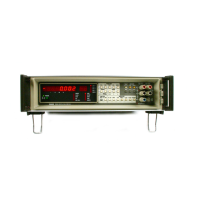ASCI!
OUTPUT
FORMAT
±
Digits
4,
5, 6, 7,
8
±
CR
I £==—1^
-v I
I
1 2 3
4
5 6 7
8
9 10 11
12
13 14 15
—
v-
—
—
' i
t
I
Digits
1,
2, 3
and
'
E Exp
LF
decimal point.
Digit
8
is used only on the 10V dc range
to yield IVz digit
resolution.
On all other ranges
and functions,
6%
digit
resolution is used and digit 8 is set to 0.
OFFSET
COMMAND CHARACTERS
When storing the previous reading
as an offset, both
the 8505A and
the 8506A
use the displayed value in the same
manner
as does
the
8502A.
LIMITS AND
PEAKS COMMAND
CHARACTERS
When Limits testing
is enabled (U), an error is identified
by either of the following
responses:
1. The standard error response message
(programmed with the K3
command) is normally
returned.
2. If no such standard
error
response message has been programmed
sincethe last
power-up or reset,
a
"2"
is returned to identify an error occurring during
limits testing.
CONTROL
COMMAND CHARACTERS
ASCII Data
Output Format
Digit 7 is
used
with
the 8505Aand 8506A whenever
6V2
digits
of resolution are available. If
5V2 digits are available, digit
7 is not needed
and is consequently set to 0.
CALIBRATION
CONSTANT
The Calibration Memory
is a
standard feature of
the 8505A
and
8506A. Therefore, the
M
and
MO commands may
be used
at any time to inhibit
or enable all Calibration Memory
gain correction factors:
M: inhibit
all calibration gain correction factors.
,
MO: enable
calibration
gain correction factors.
The Ml and
M2 commands may be used to
inhibit
or enable the
temporary zero correction
factors
stored
with
the
K0
and
K1 commands (V DC and OHMS only). This has the same effect as turning the
Zero
mode
off and on with
the
ZERO push
button, except
the
M2
command does
not store zeros;
Ml: inhibit zero correction values (turn
Zero
mode off).
M2: enable zero correction values (turn Zero mode on).
The temporary zero correction factors are applied in dc volts (V) or ohms (Z)
whenever the M2 command is in effect
(i.e.,
whenever
Zero mode is on).
When
the multimeter is powered-up
or reset, the Zero mode is turned on and the temporary
zero correction factors are reset to 0. During normal operation (Calibration mode
off), the “permanent” zero correction
factors in Calibration Memory are always in effect, and are not affected
by
the
Ml
and M2
commands.
Calibration Memory allows for software calibration of all functions and is fully described in
Appendix
7B. Although
software calibration
procedures are not discussed here, the
following considerations must
be
observed if Calibration
mode
is
turned on (the Calibration mode is enabled or disabled with the rear
panel
Calibration Switch when the
multimeter is in local control):
1.
Calibration correction
factors
are
always applied
to
readings
unless the M
command is sent.
This is true
whether Calibration mode is on or off.
2. When Calibration mode is on, the
Ml and M2 commands
enable and disable
the “permanent”
zero
correction factors stored in Calibration Memory. Temporary zeros are not
used in Calibration
mode.
3.
When Calibration mode is
on, the resolution available
for each range and function
is the same
as
for
Average mode
(refer to RANGE COMMAND
CHARACTERS).

